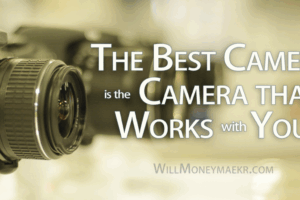Cameras are truly marvelous devices, capable of capturing moments and turning them into lasting memories. They can freeze time, tell stories, and evoke powerful emotions. But here’s the catch – a camera can only do these incredible things if you have it with you when the perfect photographic opportunity arises. Mark Twain once said, “The person who does not read has no advantage over the one who cannot read.” The same goes for photography: if you leave your camera at home, you’re no better off than someone who doesn’t own one.
The Missed Opportunities
Picture this: you’re out for a walk on a stunning autumn day. The sun casts a golden glow on the vibrant leaves, and a gentle breeze sends them dancing through the air. It’s a scene straight out of a painting, just begging to be captured. You reach for your camera – only to realize it’s at home. That perfect moment slips away, leaving you with nothing but a fleeting memory.
We’ve all been there. Those moments of regret when we stumble upon a breathtaking scene or a fleeting human connection, only to find ourselves unprepared. Photographic opportunities are everywhere, often appearing when we least expect them. If you don’t have your camera, you risk missing out on moments that can never be recreated.
Finding Magic in the Everyday
One of the joys of photography is discovering the extraordinary in the ordinary. Everyday life is full of magical moments that make for compelling photographs. A child’s laughter, the interplay of light and shadow on a city street, or the quiet beauty of morning dew on a spider’s web – these scenes can turn into stunning images, but only if you have your camera with you.
Carrying your camera at all times helps you see the world through a photographer’s eyes. It makes you more observant, more attuned to the details and moments that others might overlook. With your camera in hand, you’re always ready to capture the unexpected beauty and fleeting moments of life that tell powerful stories.
The Art of Being Prepared
Photography isn’t just about technical skills and artistic vision; it’s also about being prepared. Professional photographers know this well. They understand that some of their best shots come from being in the right place at the right time – and being ready to capture the moment. That’s why many photographers make it a habit to carry their cameras with them wherever they go.
To embrace this mindset, consider investing in a camera that’s portable and easy to carry. Mirrorless cameras, compact DSLRs, and even high-quality smartphones can be excellent choices for everyday carry. The key is to have a camera that you’re comfortable taking with you, whether you’re heading to work, running errands, or going for a hike.
The Convenience of Smartphone Cameras
For many people, not having a camera seems strange because they always have one – their smartphone. Modern smartphones are equipped with advanced camera technology, making them powerful tools for capturing high-quality images. The convenience and portability of smartphone cameras mean that most of us are never without a camera, and this has transformed the way we approach photography.
Smartphone cameras have democratized photography, allowing more people to capture and share their experiences instantly. The saying “the best camera is the one you have with you” has never been truer. With a smartphone in your pocket, you’re always ready to capture those unexpected moments, from a beautiful sunset to a spontaneous street scene.
The Limitations of Smartphone Cameras
While smartphone cameras are incredibly convenient and have made photography more accessible, they still have limitations compared to professional cameras with interchangeable lenses. Let’s break it down:
1. Image Quality: Professional cameras typically have larger sensors that capture more light and detail, resulting in higher resolution images with greater dynamic range and better low-light performance. Despite advancements, smartphone cameras still struggle to match the image quality of a high-end DSLR or mirrorless camera.
2. Interchangeable Lenses: One of the biggest advantages of professional cameras is the ability to change lenses. This allows photographers to choose the best lens for the situation, whether it’s a wide-angle lens for landscapes, a macro lens for close-ups, or a telephoto lens for distant subjects. Smartphone cameras, with their fixed lenses, can’t offer the same level of versatility.
3. Manual Controls: Professional cameras provide extensive manual controls over settings like aperture, shutter speed, and ISO, allowing photographers to have precise control over their exposures and achieve creative effects. While some smartphones offer manual mode, it’s often less intuitive and doesn’t provide the same level of control as a dedicated camera.
4. Durability and Ergonomics: Professional cameras are built to withstand challenging conditions and are designed for comfort during long shoots. They have better battery life, more robust build quality, and are often weather-sealed. Smartphones, while convenient, are not as rugged and can be awkward to use for extended photography sessions.Maximizing Your Smartphone Camera’s Potential
Even though smartphone cameras have limitations, there are ways to maximize their potential to ensure you’re capturing the best possible images:
1. Learn Your Camera’s Features: Take the time to explore and understand the features of your smartphone camera. Most modern smartphones offer a range of settings and modes, such as portrait mode, night mode, and manual controls, that can enhance your photography.
2. Use Editing Apps: Post-processing can elevate your smartphone photos from good to great. There are numerous editing apps available that allow you to adjust exposure, contrast, color, and more. Some popular options include Adobe Lightroom, Snapseed, and VSCO.
3. Invest in Accessories: Consider investing in accessories like clip-on lenses, tripods, and stabilizers. These tools can expand the capabilities of your smartphone camera, allowing you to capture a wider range of shots and improve stability for clearer images.
4. Practice Composition: Just like with any camera, composition is key to creating compelling images. Practice the rule of thirds, leading lines, and framing to add interest and balance to your photos.
5. Be Mindful of Lighting: Lighting can make or break a photograph. Pay attention to the quality and direction of light, and experiment with different lighting conditions to see how they affect your images. Natural light is often the best choice for vibrant, well-exposed photos.The Challenge of Remembering to Capture Moments
Here’s the funny thing – even with a smartphone camera always in your pocket, there are still times when you forget to take a picture. You might be at a great place, witnessing a beautiful sunset, or meeting someone special, but the thought of capturing the moment slips your mind. It’s crazy to think about, but it happens more often than we realize.
Sometimes, we’re so caught up in the experience that we forget to document it. Other times, we might hesitate, unsure if the moment is “worth” capturing. And occasionally, we might simply underestimate the significance of the moment until it has passed.
Embracing the Unexpected
One of the most exciting aspects of carrying your camera everywhere is the element of surprise. You never know when a remarkable moment will unfold before your eyes. It could be a dramatic sunset, an unexpected encounter with wildlife, or a candid moment of human emotion. By having your camera with you, you’re ready to embrace the unexpected and turn these moments into lasting images.
Consider the story of renowned street photographer Henri Cartier-Bresson. He was known for always carrying his camera and being ready to capture the “decisive moment” – that split second when all the elements of a scene come together to create a powerful image. His iconic photographs, such as “Behind the Gare Saint-Lazare,” were made possible by his unwavering commitment to always being prepared.
Conclusion
Cameras are incredible devices that can do remarkable things, but their potential is only realized when they are with you, ready to capture the world as it unfolds. As Mark Twain wisely pointed out, those who don’t read have no advantage over those who can’t. Similarly, a person who leaves their camera at home has no advantage over those who don’t own a camera. By making it a habit to carry your camera with you, whether it’s a high-end DSLR or the smartphone in your pocket, you open yourself up to a world of photographic opportunities. You become more observant, more prepared, and more capable of capturing the extraordinary moments that make life so beautiful. So, grab your camera and step out into the world – you never know what amazing scenes await you.





